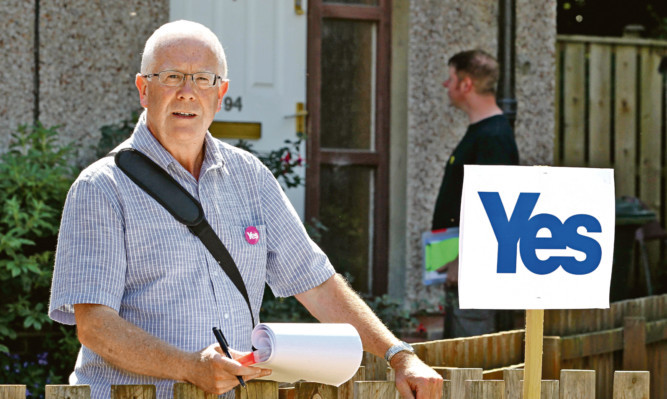
We follow a group of campaigners out knocking on doors and making their points in a typical Scottish village
“I have Yes and No days,” confides Darren, visibly struggling with his voting dilemma as he grasps the gate post of his Stirlingshire home like it is a Rubik’s Cube.
He knows the Yes canvasser in front of him Steven Paterson, a local SNP councillor from their school days and earnestly tells him how he’s been reading up on the arguments online.
But the 40-year-old father-of-four is not quite there, either way.
“I talk to my pals, the guys down the bowling club, but I still don’t know. It’s my kids I’m most bothered about, what future it will leave them?”
Blistering sunshine makes canvassing in the pretty village of Cambusbarron pleasant work for the cheery group of Yes campaigners I’m shadowing. Marshalling the troops is Stirling’s Nationalist MSP Bruce Crawford.
He works through his target list of houses with the upbeat bustle of a market trader, the street-wise operator more than happy to put Yes voters my way as I follow his team up the village’s Gillies Hill.
“For a change you’ll know which MSPs have been really working when we go back to Holyrood by their suntans,” jokes Bruce, though as a former chief whip he’s probably only half joking.
Gillies Hill is a well-kept “bought house” neighbourhood where I speak with retired soldiers, coach builders, green keepers, care assistants and shop workers.
The working class of Scotland. People who the Yes camp needs to win over in the next eight weeks if they are to turn around polls which have them heading for defeat.
Tony Kelly, a housing consultant, is not on the Yes database as a supporter but is an easy hit. The 56-year-old cares little for the policy bun fights, such as free childcare, which have dogged the referendum debate.
He explains, “For me it is simple, it is just the principle that we should be in charge of our destiny. I don’t support Alex Salmond and his right-wing, business friendly vision of Scotland but I support independence.”
Janet Cummings, a 59-year-old care worker, offers up a can of Irn Bru as she explains why she is far from sold on the idea of independence.
“I just think it is wrong. United we stand, united we fall. I’m no fan of David Cameron, by the way. None of the politicians are doing anything for the working classes and I don’t think independence would change that.“
Charlie Moore, clearing up her front garden, catches breath as Steven unfurls his well-oiled Yes pitch. She’s pleasant but unmoved.
The 26-year-old later confides, “I’m undecided, I just don’t know who to believe to be honest.”
Typically, the pro-independence voters are keen to talk, the No voters are less so apologetically spurning the Yes advances like they’re avoiding pushy charity collectors in the street.
A common comment among the Yes voters is “we’ve got nothing to lose” but almost uniformly they agree independence is a gamble but they are comfortable with that.
As unemployed chef John McDermott puts it, “It’s a gamble but I’ve studied the form”.
It’s an honesty to the situation not always forthcoming from those leading the Yes campaign.
As I leave, the scholarly 81-year-old Edward Goldie points out to me Gillies Hill is where Robert the Bruce’s camp followers took shelter before their famous charge which won the Battle of Bannockburn and ultimately Scottish independence.
If lightning is to strike twice then it is in working class streets like this where the battle will be won.

Enjoy the convenience of having The Sunday Post delivered as a digital ePaper straight to your smartphone, tablet or computer.
Subscribe for only £5.49 a month and enjoy all the benefits of the printed paper as a digital replica.
Subscribe